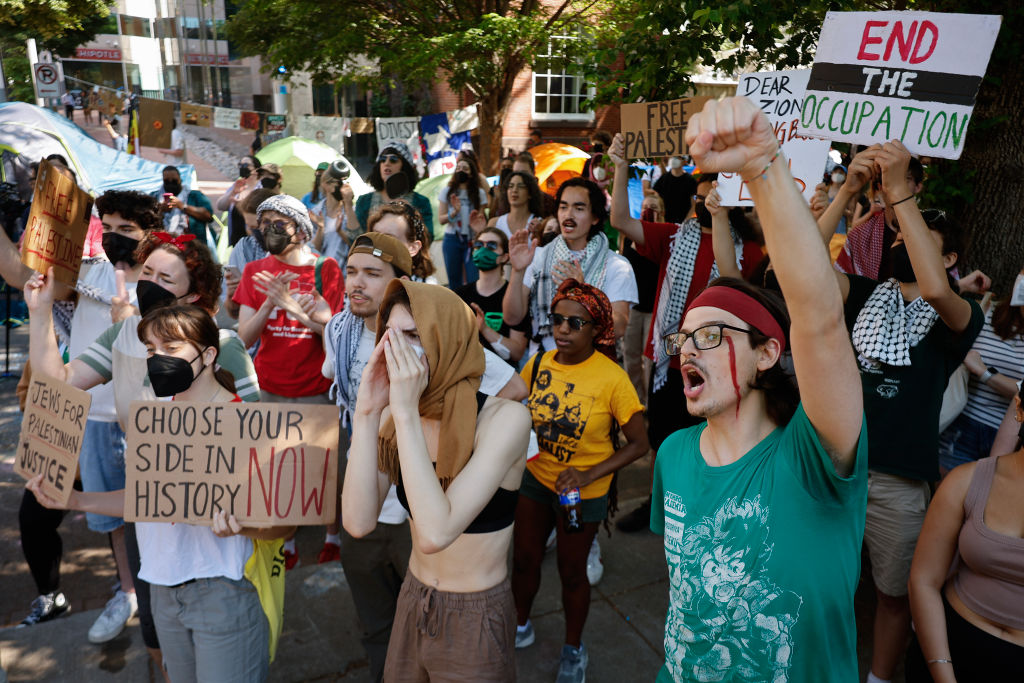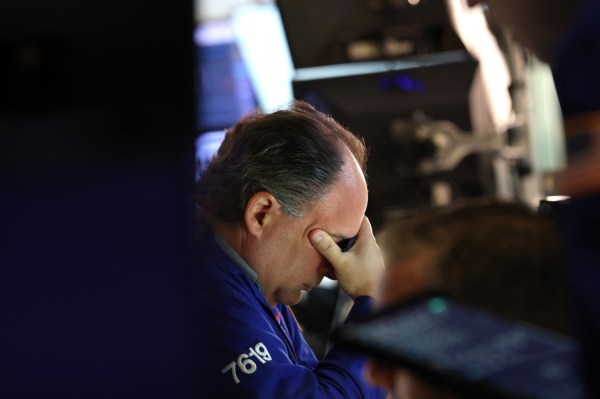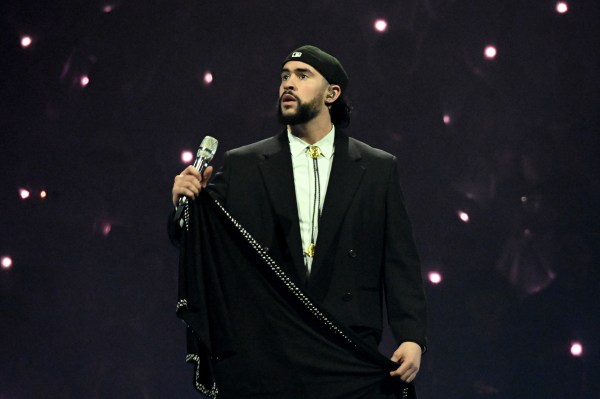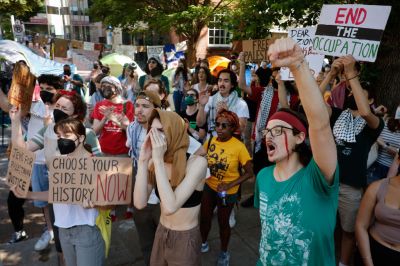Every few years another seismic tremor roils American educational institutions: DEI and critical race theory, transgender bathroom use and sports participation and library books, ChatGPT and AI tools, and now protests over the war in Gaza. The ferocity that characterizes these disputes is sometimes seen as the result of increasing political polarization, and that’s no doubt part of the story. But the underlying cause of such fierce and incommensurable disagreements is that America’s secular schools have increasingly set aside transcendent questions about human purpose and responsibility.
This claim may seem counterintuitive given common intuitions that see religion as a source of conflict, but in the absence of a shared, robust understanding of human purpose, the educational enterprise will inevitably founder. As the varied and often conflicting moral claims advanced by Gaza-war protesters indicate, as the inconsistent and often draconian actions of college administrators suggest, the divorce between knowledge and its ends isn’t sustainable. American schools used to be able to function without explicit theological missions because there was a largely shared moral and religious consensus within the communities they served. Needless to say, that’s no longer the case.
Alasdair MacIntyre opens his classic After Virtue with a parable that illuminates why our culture’s moral disputes are both intense and irresolvable. MacIntyre invites readers to imagine some sort of civilizational collapse that causes scientific learning to be forgotten. Generations later, people seek to revive the natural sciences from the fragments that remain—half-burnt books, stray equipment, recalled theorems. But the whole that would make sense of them is forgotten: “In such a culture men would use expressions such as ‘neutrino’, ‘mass’, ‘specific gravity’, ‘atomic weight’ in systemic and often interrelated ways which would resemble in lesser or greater degrees the ways in which such expressions had been used in earlier times before scientific knowledge had been so largely lost. But many of the beliefs presupposed by the use of these expressions would have been lost and there would appear to be an element of arbitrariness and even of choice in their application which would appear very surprising to us.” Something very much like this, MacIntyre argues, is what has happened to our culture’s moral reasoning. And matters haven’t improved in the 40-plus years since he wrote this book.
We still possess a “simulacra of morality.” We still have heated debates about right and wrong. But because of the “conceptual incommensurability” among our rival fragments, moral arguments devolve into “pure assertion and counter-assertion,” and mutual understanding—much less genuine persuasion—rarely occurs. MacIntyre’s account of this kind of build-your-own bricolage morality, one that takes bits and pieces from various traditions and sources, aptly describes the protester slogans and counterslogans, the staged congressional testimonies and feckless administrator press releases, and the moral grandstanding on social media that denounces various video clips and screenshots. Everyone wants to lay claim to the moral high ground, but there’s no agreement on where that high ground might be found.
These disputes become particularly heated at colleges and universities because the task of educating people necessarily entails assumptions about the nature and proper end of persons. Such fruitless moral posturing illustrates why we can’t educate students without addressing, at least implicitly, the question that forms the title of one of Wendell Berry’s books: “What are people for?” Historically, the first European universities were founded on the assumption that the highest human ends were religious, and the curriculum was oriented toward theology, the queen of the sciences. Similar convictions shaped America’s first universities. As America gradually became more religiously pluralistic, private and public universities articulated human ends in terms of citizenship and republican government. Remnants of both these purposes remain at various institutions, but the default purpose of education is now, as Berry puts it, “the mass production of producers and consumers.”
In the service of this objective, universities have largely bracketed transcendent questions; such debates prove too divisive among their many constituents. MacIntyre narrates the gradual process by which academic inquiry slowly “fragmented into a series of independent, specialized, and professional activities whose results could, so it seemed, find no place as parts in any whole.” In a similar vein, Berry remarks that rather than a coherent tree of knowledge, the “modern university … more and more resembles a loose collection of lopped branches waving about randomly in the air.” This moral chaos is the natural result, MacIntyre concludes, of relegating “moral and theological truth” to “the realm of privatized belief.”
Even while universities use more immediate ends like career preparation or the pursuit of knowledge to hold together their disparate parts, students and faculty sense these are insufficient to undergird and direct their educational endeavors; they expect—and universities have encouraged them to expect—that these institutions will speak with moral authority. Seven years ago, after a parade of antisemitic white supremacists marched through the University of Virginia campus, professor Chad Wellmon wrote an essay for the Chronicle of Higher Education that tried to make sense of why “the contemporary university, at least in its local form in Charlottesville, seems institutionally incapable of moral clarity.” Part of the answer, as Wellmon notes, is that universities are too many things. On the one hand there are the incompatible ideals: Universities are bastions of free inquiry, welcoming communities, and loci for the transmission of culture. And on the other hand, there is the sprawling reality that Clark Kerr calls “multiversities.” Wellmon remarks that the University of Virginia encompasses “a health center, a federal contractor, a sports franchise, an event venue, and, almost incidentally, a university devoted to education and knowledge.” One could also add a hedge fund and a security apparatus. Given these varied and competing identities, it’s not surprising that Wellmon concludes, “Universities cannot impart comprehensive visions of the good. They cannot provide ultimate moral ends. Their goods are proximate.”
Wellmon argues that so long as we acknowledge these limits and rely on some alternative source of moral authority in our own private lives, these proximate goods of scholarship and disciplined knowledge remain viable. Yet as suggested by the recurring moral crises that sweep through universities, the incoherent bricolage of social justice, career training, and therapeutic self-help can’t sustain and orient education. Education’s proximate goods are only intelligible when they remain in the service of ultimate goods.
Yet I think MacIntyre is right to find paradoxical grounds for hope in the series of moral crises that have revealed the incoherence of modern educational institutions. Insofar as the defenders of the academic status quo—the acquisition and discovery of specialized, fragmented, and value-neutral skills or information most relevant to career preparation—have “responded with stuttering ineptitudes” to the stresses confronting their institutions, there is a real opportunity for colleges that stand in a coherent moral tradition to offer an alternative. MacIntyre terms this alternative “traditioned inquiry,” in which teachers and students pursue the work of education as participants within a particular moral or religious tradition. A community with a shared backdrop of moral and theological commitments can carry out intense but coherent prudential debates regarding the ends that knowledge should serve.
I teach at a Christian liberal arts college that aspires—imperfectly, of course; it’s an institution populated by fallen persons—to carry on such inquiry. When I teach our first-year writing course, we consider rhetoric not just as the art of persuasion, but as the art of persuading another of truth. Quintilian’s famous adage, that rhetoric is the good man speaking well, names this inherent connection between a writer’s character and purpose and the effectiveness of the argument being made. If you bracket all questions about the former, you end up with sophistry. Similarly, in my environmental ethics course this spring, we approach fraught questions through our shared affirmation of the biblical narrative. This doesn’t neatly resolve difficult issues of what we owe other creatures, and it doesn’t mean we read only Christian authors. In our class discussions of Peter Singer, Martha Nussbaum, George Monbiot, or Robin Wall Kimmerer, we allow these authors to put our tradition to the test and expose its shortcomings, but we do so as participants in and adherents of the Christian moral tradition.
At a panel discussion last fall to mark the release of a book I co-edited, The Liberating Arts: Why We Need Liberal Arts Education, one of the audience members asked whether liberal arts education can survive if we don’t take religion seriously. Roosevelt Montás, a faculty member at Columbia who served for a decade as the director of its core curriculum program, replied that while it depends on how religion is defined, “I do think that liberal education necessarily involves a question of ultimate values.” While he and other panelists noted the possibilities for such education to occur in pluralistic, non-confessional institutions, that window of opportunity seems to be narrowing.
Situating education within an explicit religious tradition isn’t a panacea for navigating our culture’s bricolage morality. Many religious colleges struggle to maintain their missional commitments in the face of politicized criticism. And many more religious colleges allow rifts to open between their public confessions of faith and their de facto educational culture and practice. But if the aspiration to “traditioned inquiry” isn’t a sufficient condition for healthy educational institutions, it’s at least a necessary condition.
In a recent essay on the challenges of fostering hard conversations in this cultural context, Leah Libresco Sargeant describes how irresolvable moral disagreements poison educational institutions: “A culture that can’t ultimately settle ideological disagreements can’t run a school worthy of the name.” Sargeant goes on to clarify this point: “A school can’t be run by delicate détente, suspending judgment on every issue that prompts division. But it also can’t be run by picking winners and losers, where the outvoted losers feel like what they’ve risked and lost is their children.” As much as I mourn the loss of America’s remarkable tradition of public education, at both the K-12 and university levels, it’s becoming harder to imagine how these institutions can continue to function downstream from our culture’s moral fragmentation.
Elite private colleges and big state schools will stagger on. They have too much money to fade easily. But their moral authority will continue to erode, and more and more people may turn to smaller institutions with clear missions. When small colleges are in the news, it tends to be because they are downsizing or closing their doors. But micro colleges are also springing up around the country. In the same way the tragic dysfunctions of K-12 public schools are fueling the incredible growth of classical schools, many of which are explicitly religious, the moral decadence of prominent universities may generate a parallel wave of interest in religious, liberal arts colleges, colleges oriented toward an explicit vision of human purpose. These institutions will still be sites of intense and necessary debate, but they can offer a context in which disagreements might promote learning and moral clarity. Many American universities can apparently no longer provide such contexts.






Please note that we at The Dispatch hold ourselves, our work, and our commenters to a higher standard than other places on the internet. We welcome comments that foster genuine debate or discussion—including comments critical of us or our work—but responses that include ad hominem attacks on fellow Dispatch members or are intended to stoke fear and anger may be moderated.
With your membership, you only have the ability to comment on The Morning Dispatch articles. Consider upgrading to join the conversation everywhere.